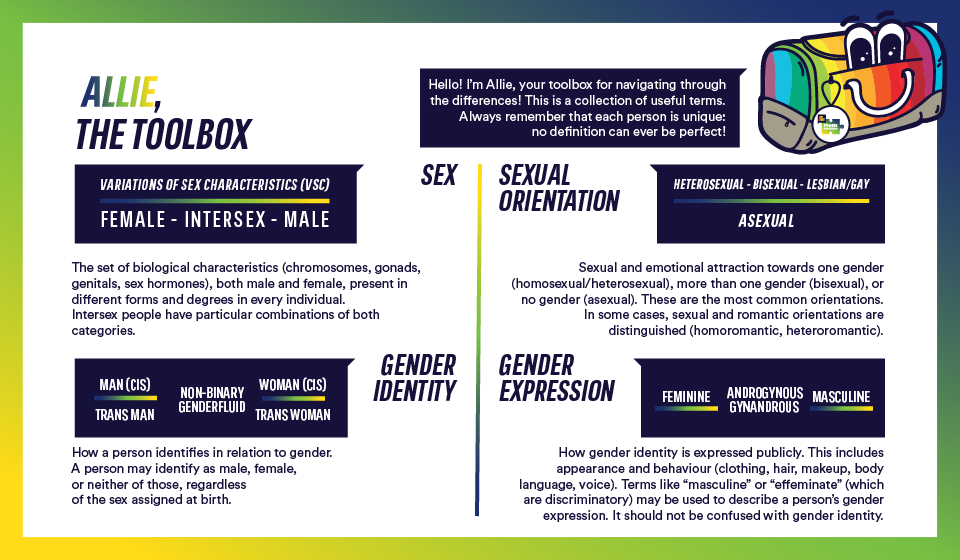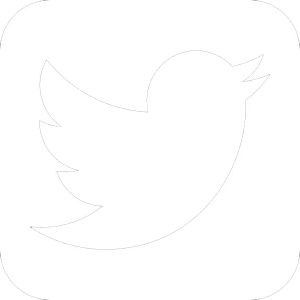
- LGBTQIA+: Acronym used to refer to people who are not heterosexual or cisgender, or who don’t fit into traditional social expectations related to their gender. The Ipsos Pride 2023 survey affirms that about 9% of the global population identifies as LGBTQIA+. Additionally, 3–6% of the population (lower in older generations and higher in younger generations) identify as transgender or non-binary, meaning they don’t fit within the traditional male-female binary. In scientific contexts, the acronym TGD (transgender and gender diverse) includes individuals who do not conform to conventional gender norms in identity or expression. Another umbrella term used for this group is “gender non-conforming.”
- Lesbian: A woman who is sexually and/or emotionally attracted to women.
- Gay: A person who is sexually and/or emotionally attracted to people of the same gender. It traditionally refers to men, but others who are attracted to the same gender or multiple genders may also identify as gay.
- Bisexual: A person who is emotionally and/or sexually attracted to individuals of more than one gender.
- Transgender: A person who identifies differently from the sex assigned at birth (see below).
- Queer: A term that has been reclaimed by individuals who generally identify beyond traditional gender categories and heteronormative social norms.
- Intersex: People who are born with sexual characteristics (sexual anatomy, reproductive organs, hormonal structures and/or levels, and/or chromosomal patterns) that do not fit typical definitions of male or female (see below).
- Asexual: A person who is not sexually attracted to other people or who experiences attraction in varying degrees that differ from the prevalent narrative about sexuality.ggg
- SOGIESC: Acronym used to refer to universal personal characteristics related to gender, sexualities, and relationships. It refers to:
- Sexual Orientation
- Gender Identity
- Gender Expression
- Sexual Characteristics
- Sex (better refers to sexual characteristics): The set of biological characteristics, including chromosomes, gonads, genitals, and sex hormones, both male and female, present in varying degrees and forms in each individual. Intersex people have unique combinations of characteristics from both categories.
- Science refers to “Sex assigned at birth” as the sex assigned to an individual at birth based on the appearance of their external genitals. Some individuals have a particular combination of male and female sexual characteristics that does not allow for an immediate classification (intersex people). The sex assigned at birth on documents corresponds to social expectations associated with the corresponding gender (think of the blue and pink ribbons).
- Variations in Sexual Characteristics (VSC): An umbrella term that refers to variations in sexual characteristics compared to conventional standards. It is also sometimes referred to as DSD (Differences of Sex Development). Hyperandrogenism refers to women with higher-than-average testosterone levels (e.g., Caster Semenya), and intersex refers to individuals with chromosomal, gonadal, and/or anatomical characteristics that do not fit typical definitions of male or female. Both fall within the VSC spectrum. Intersex individuals are estimated to comprise about 0.5% to 1.7% of the global population (Unfe.org). Several countries, including Australia, New Zealand, and Germany, offer the option of a third sex classification on birth certificates. Additionally, around 30 countries, such as the United States, India, Argentina, Iceland, Malta, Canada, and Mexico, recognize a third gender option for gender affirmation requests.
- Gender. The set of characteristics that, in a given society, distinguish the ideas of masculinity and femininity. It is a concept linked to the evolution of customs and culture.
- Gender identity. How a person identifies themselves in relation to gender. A person may identify as a man, a woman, or differently from both, regardless of the sex assigned at birth. It should not be confused with sexual orientation, which refers to sexual and emotional attraction toward one or more genders, or none at all.
- Gender variance. An umbrella term for individuals whose gender expression does not conform to the usual social expectations associated with the gender assigned at birth (male or female). It is particularly used for children and adolescents. As clarified by the last Standards of Care for the Health of Transgender and Gender Diverse People, Version 8, gender diversity in childhood is “an expected aspect” of general human development.
- Transgender (trans person). Transgender individuals have a gender identity that does not correspond to the sex assigned at birth. They can be trans women if they were assigned male at birth and have undergone gender affirmation as women. They can be trans men if they were assigned female at birth and have undergone gender affirmation as men. It can be also used an umbrella term (sometimes wrote as “trans*”) that includes anyone who have a gender identity that is different from their gender assigned at birth and people who wish to portray their gender identity in a way that is different from expectations based on their gender assigned at birth.
- Non-binary (non-binary person). Individuals who do not identify strictly as male or female. In some cases, they may choose a name different from the one assigned at birth. Depending on their socialization, they may prefer to participate in sports in either the male or female category.
- Gender expression. Gender expression is how a person publicly expresses or presents their gender. This can include behavior and outward appearance such as clothing, hair, makeup, body language, and voice. It is a concept distinct from gender identity.
- Sexual orientation. The sexual and/or emotional attraction a person may feel for people of the same gender, a different gender, or more than one gender.
- Sexual behaviour: a term referring to an individual’s sexual activity, regardless of their sexual orientation.
Sources
ILGA-Europe – Glossary. https://www.ilga-europe.org/about-us/who-we-are/glossary/
TGEU – Trans Media Guide. Thttps://www.tgeu.org/files/uploads/2023/11/TGEU-Trans-Media-Guide-EN.pdf
OII Europe – Topics. https://www.oiieurope.org/topics/
Wpath – Standards of Care for the Health of Transgender and Gender Diverse People, Version 8. https://www.tandfonline.com/doi/pdf/10.1080/26895269.2022.2100644
Outsport Toolkit – https://www.out-sport.eu/wp-content/uploads/2024/03/OUTSPORT-TOOLKIT-EDUCATION-THROUGH-SPORT.pdf

CONTACT US
info@outsport.eu
press@out-sport.eu
+39 06 4203941
sbdtbst

![]()